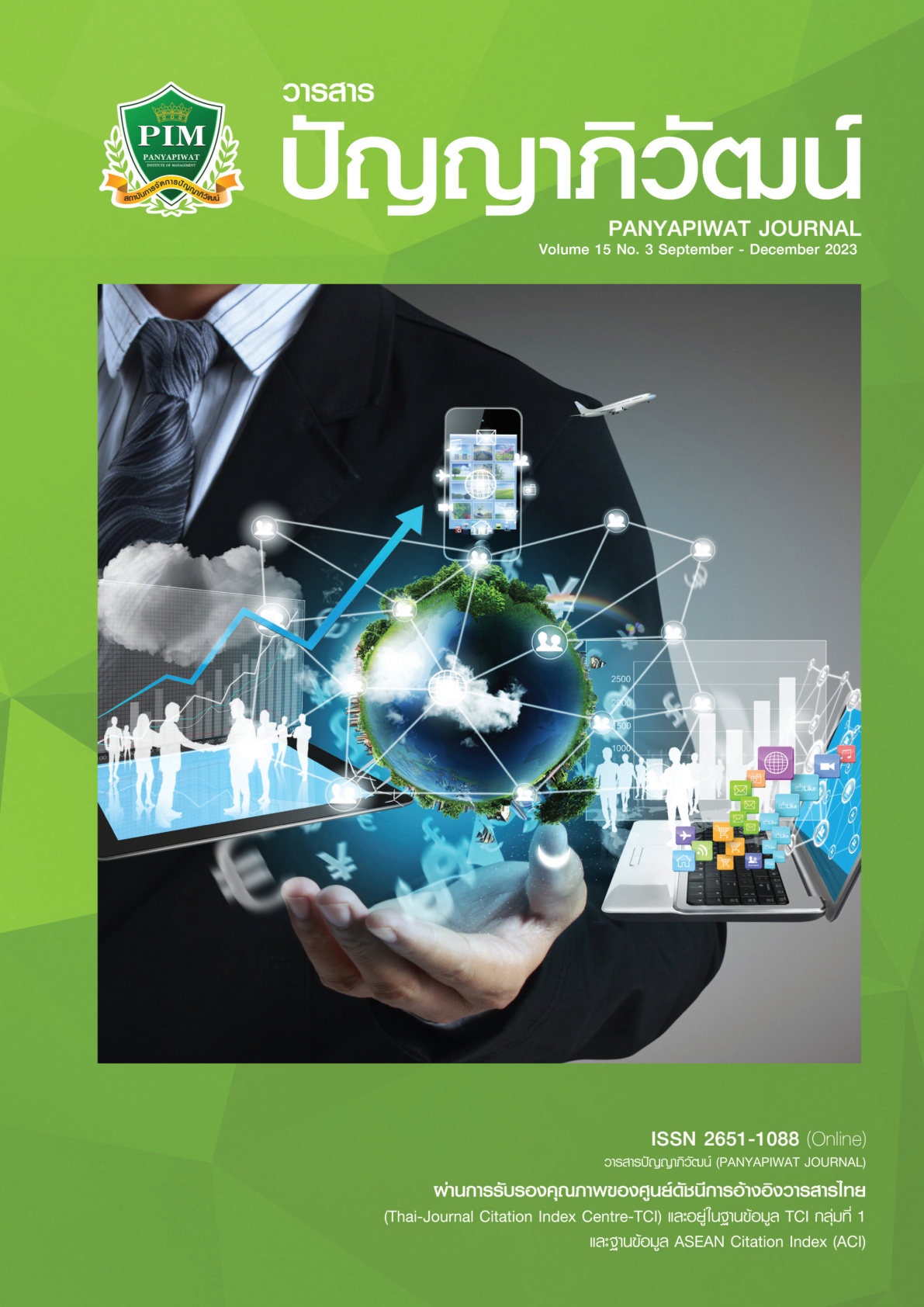THE ACCEPTANCE OF MOBILE APPLICATION USAGE AMONG THE SOCIAL BOUND ELDERLY IN THAILAND
Main Article Content
Abstract
This study aims to investigate the factors that affect the intention of using the mobile application of the social bound elderly in Thailand. The data from 480 social bound elderly in Thailand were collected by a questionnaire and then analyzed by percentage, mean, standard deviation, and multiple linear regression analysis.
The research findings showed that the majority of the sample group members consisted of females, aged between 60 and 69 years, accounting for 61.0%. Within the sample group, 81.9% were married, and their educational level was at the secondary school level (33.8%). Regarding income, 20.2% had an income ranging from 30,001 to 35,000 baht. Furthermore, 76.7% of the sample group members resided with their children or relatives, with 90.4% being able to take care of themselves and 64.6% participating in social activities occasionally. As for the factors affecting the intention of using the mobile application of the elderly in Thailand, it was found that there were four factors as follows: (1) habitual factor (p < .001), (2) entertainment motivation factor (p < .001), (3) factor of condition facilitating the use of mobile application (p < .001), and (4) social influence factor (p < .001). The multiple linear regression equation is shown below: ŷ = .887 + .605𝒳7 + .233𝒳5 - .168𝒳4 + .141𝒳3 (SEE = 0.408, R2 = 0.677, adj. R2 = 0.674) It could predict the intention of using the mobile application of the elderly in Thailand by 67.4%.
Article Details

This work is licensed under a Creative Commons Attribution-NonCommercial-NoDerivatives 4.0 International License.
I and co-author(s) certify that articles of this proposal had not yet been published and is not in the process of publication in journals or other published sources. I and co-author accept the rules of the manuscript consideration. Both agree that the editors have the right to consider and make recommendations to the appropriate source. With this rights offering articles that have been published to Panyapiwat Institute of Management. If there is a claim of copyright infringement on the part of the text or graphics that appear in the article. I and co-author(s) agree on sole responsibility.
References
Department of Older Persons. (2020). Strategy of the department of elderly affairs 20 years 2018-2037. https://www.dop.go.th/download/knowledge/th1539-326153-138_0.pdf [in Thai]
Department of Older Persons. (2022). Statistics on the number of elderly people in Thailand from 2017 to 2022. https://www.dop.go.th/th/know/side/1/1/1159 [in Thai]
Foundation of Thai Gerontology Research and Development Institute. (2018). Active and productive aging: Challenges that Thailand must meet. Foundation of Thai Gerontology Research and Development Institute. [in Thai]
Foundation of Thai Gerontology Research and Development Institute. (2022). Situation of the Thai older persons 2021. Institute for Population and Social Research Mahidol University. [in Thai]
Health data center. (2022). Percentage of healthy aging fiscal report. https://hdcservice.moph.go.th/hdc/reports/report.php [in Thai]
Jumneansuk, A. (2018). Quality of life among home bound elder in Sakaeo Province. VRU Research and Development Journal Science and Technology, 13(3), 1-11. [in Thai]
Kaewkingchan, W. (2021). The lifestyle of the elderly affecting the use of communication innovation [Master’s thesis]. Naresuan University. [in Thai]
Khamrod, S., & Srikhaetai, K. (2018). The multiple regression model for learning achievement in science and mathematics of undergraduate y students. Apheit Journal, 7(1), 92-103. [in Thai]
Kleechaya, P. (2021). Research on the use of digital technology of the elderly and proposals for enhancing the power of the Thai elderly. https://opac01.stou.ac.th./cgi-bin/koha/opac-detail.pl?biblionumber=1624-85&shelfbrowse_itemnumber=563048 [in Thai]
Lee, C. C., Czaja, S. J., & Sharit, J. (2008). Training older workers for technology-based employment. Educational Gerontology, 35(1), 15-31.
National Statistical Office. (2015). Factors affecting internet usage for the elderly in Thailand 2014. http://www.nso.go.th/sites/2014/DocLib13/%E0%B8%94%E0%B9%89%E0%B8%B2%E0%B8%991CT [in Thai]
Nochot, B. (2021). Experience and technology acceptance of Post-retirement people in Bangkok and Metropolitan area that affected willingness to use e-book [Master’s thesis]. Silpakorn University. http://ithesis-ir.su.ac.th/dspace/handle/123456789/3597 [in Thai]
Nunnally, J. C. (1978). Psychometric theory (2nd ed.). McGraw-Hill.
Office of the National Economic and Social Development Council. (2019). Trends in the number of elderly people in Thailand. http://www.nesdb.go.th/main.php?filename-=index
Office of the Permanent Secretary, Ministry of Public Health. (2022). Hospital activities. http://bps.ops.moph.go.th/H.doc [in Thai]
Quan-Haase, A., Mo, G. Y., & Wellman, B. (2017). Connected seniors: How older adults in East York exchange social online and offline. Information, Communication & Society, 20(7), 967-983.
Phansuwan, L. (2019). Factors affecting demand for technology media learning in the technology confluence era of the elderly in Nakhon Sawan Province [Master’s thesis]. Faculty of Management Sciences Nakhon Sawan Rajabhat University. [in Thai]
Pitutacha, S. (2021). Health promotion and elderly care innovation conference. https://www.thailandplus.tv/archives/450239 [in Thai]
Puthong, T. (2017). Factors influencing the elderly’s willingness to accept health services via mobile phones. Thai version, Humanities, Social Sciences and Arts. Faculty of Management Sciences Silpakorn University, 10(3), 548-566. https://he02.tci-thaijo.org/index.php/Veridian-E-Journal/article/view/104191 [in Thai]
Srijam, A. (2019). Factors affecting access to technology of the elderly in the digital age [Master’s thesis]. Digital Economy Program Institute of Economics Graduate School, Rangsit University. [in Thai]
Thidarat, S. (2018). Information need to improve quality of life for the elderly of elderly school in Ma-Aue Sub-District, Thawatburi District, Roi-Et Province. NRRU Community Research Journal, 12(3), 114.
Torres, W. J., Bradford, B. C., & Beier, M. E. (2019). Technology and the aging worker a review and agenda for future research. In R. N. Landers (Ed.), Cambridge handbook of technology and employee behavior (p. 608). Cambridge University Press. [in Thai]
Tulanont, S. (2019). The acceptance of technology that affects the decision to buy online products of the elderly [Master’s thesis]. Naresuan University. [in Thai]
Viswanath, V., James, T., & Xu, X. (2012). Consumer acceptance and use of information technology: Extending the unified theory of acceptance and use of technology. MIS Quarterly, 36(1), 157-178. https://doi.org/10.1111/j.1540-4560.1981.tb02627.x
Wanichyanukroh, D. (2015). Internet acceptance process for elderly quality of life development dissertation [Doctoral dissertation]. Communication Arts, Sukhothai Thammathirat Open University. [in Thai]
Xu, L. (2021). Middle-aged and elderly users’ continuous usage intention of health maintenance-oriented WeChat official accounts: Empirical study based on a hybrid model in China. https://bmcmedinformdecismak.biomedcentral.com/articles/10.1186/s12911-021-01625-4


